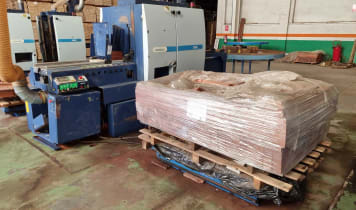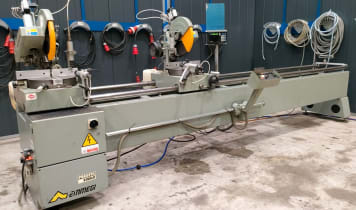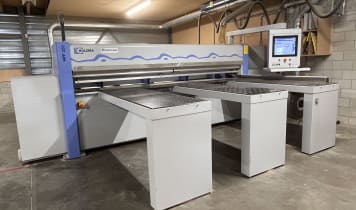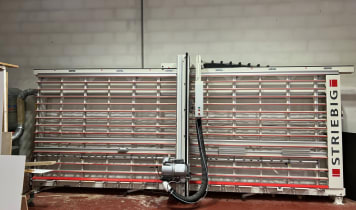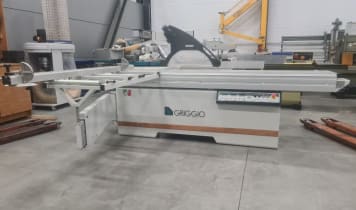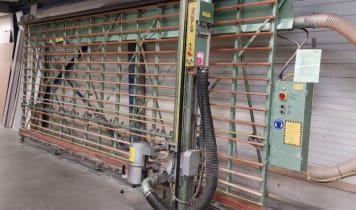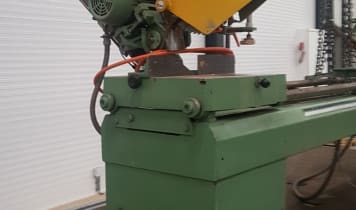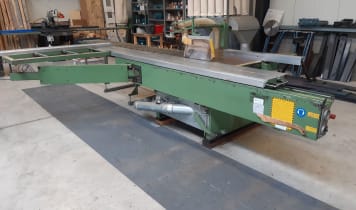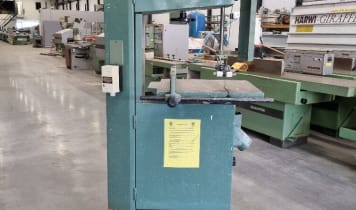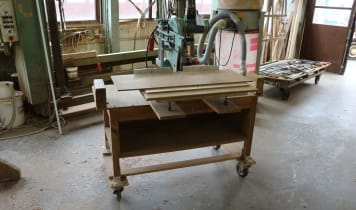The wood is harvested from the forest, cut to size in the sawmill, and sent on for further processing in the carpentry workshop. The further the raw timber is along the path to end product, the higher the precision that is required of the wood cutter machine. This is why each stage of the processing chain has its own preferred woodsaws, from either the circular saw, bandsaw or chainsaw product ranges.
Bandsaws
The sawing unit within a bandsaw consists of a loop-shaped metal belt with teeth on one side. This metal loop is clamped between a drive roller and tensioning roller.
Bandsaws are driven electrically and are available in a wide range of sizes depending on the intended application. In the sawmill, they are used for trimming logs lengthwise into planks and boards. Once cut into thin boards, they can be turned into planks through a number of side-cuts using a circular saw.
In carpentry workshops, their main use is for cutting long beams into whatever width is desired. They are technically simple and reliable machines.
Well-known manufacturers of bandsaws include:
Scroll saws
Scroll saws are a variation of the bandsaw design. Instead of a flat belt, or ‘band’, they use a thin cutting wire, which enables operators to create intricate curves and cut out workpieces radially from a given material. Scroll saws are the industrial equivalent of fret saws.
Popular manufacturers of scroll saws include BLITZ, FROMMIA, HEGNER and SCHEPPACH.
Combined trimming saws
Combined trimming saws make it possible to machine board materials on both sides within a single work cycle. This is most beneficial when it comes to batch processing precise workpieces where it increases efficiency and productivity.
On a technical level, they consist of a circular saw with two saw blades, which can be very precisely aligned with each other. In recent years, however, they have been largely replaced by panel-dividing systems and sliding table saws. They are no longer produced today but can be found on the second-hand market at very affordable prices.
The best-known manufacturers of combined trimming saws are BÄUERLE, BARBERAN and OMGA.
Sliding table saws
Sliding table saws are the standard tool of choice for carpenters and joineries. They make it possible to create extremely precise, linear cuts in panels and board materials. Sliding table saws feature a large range of settings and options, such as for maximum/minimum panel length/breadth, as well as producing precise mitres and angles.
Sliding table saws were invented by the German company ALTENDORF, which is still the market leader in this sector. A range of other companies have also turned to this machine and supply the market a wide selection of products.
The most prestigious makers of sliding table saws are:
Mitre saws
Mitres are 90° cuts into wooden profiles and strips used to create precise joints, which are widely used in parquet and laminate flooring. Mitre saws are one of the key tools of interior outfitters and the term can encompass both mitre and cross-cut saws as the machine can offer a combination of both functions.
Mitre and cross-cut saws are generally small and light enough for them to be transported from site to site. But there are also heavier, stationary mitre saws intended for carpentry workshops, which are often combination mitre saws capable of creating mitre cuts on both sides of a profile in a single work cycle.
Popular manufacturers of mitre saws include ELUMATEC, FOM, RAPID and STRIFFLER.
Cross-cut saws
Cross-cut saws are used for shortening long materials in a variety of ways, but in contrast to normal circular saws, they can only cut the short side of a slat or narrow board to the desired angle. However, the angle can be adjusted in terms of both width and depth.
A cross-cut saw comprises a machine table featuring a rotary and adjusting unit for the saw blade and a return mechanism arranged above the table. Cross-cutting involves clamping a workpiece onto the work table, adjusting the circular saw to the desired parameters, and pushing it across the material using a hand-operated lever. The result: precise cross-cuts.
Some of the best-known manufacturers of cross-cut saw are ELU, MAKITA, METABO and OMS.
Panel saws are used for efficiently dividing up large panel/board materials. They are used by furniture builders and are frequently found in hardware stores.
Panel saws generally operate using one or more circular saw units and can be extended with extra equipment, such as a turnover station. This allows panels and boards to be processed on both sides and then stacked once the procedure is complete.
HOLZMA, HOMAG, GIBEN, SCHELLING and STRIEBIG count amongst the best manufacturers of panel saws.
Multi-blade saws
Multi-blade saws enable boards, panels and chipboard to be simultaneously cut to the desired size. Depending on the type of machine, they can produce a range of strips in one or several widths in just one work cycle. Multi-blade saws are primarily used to saw wood with thin dimensions and cannot handle materials which are more than a few centimetres thick.
Popular manufacturers of multi-blade saws include RAIMANN and ABMI.
Equipment for loading & stacking in sawing machines
The efficient processing of tree trunks requires the highest performing types of transport system. The most widespread are roller tracks, conveyor belts and turnover stations, which ensure the right materials are in the correct place for ongoing processing in a sawmill or panel wood cutting machine. A wood saw also generally needs a way of clamping or holding the material in place, i.e. via magnets and gripping mechanisms, but more fragile panels and boards are frequently held via vacuum lifters, which ensure no damage to the wood.
The main producers of feeding and stacking machines for wood cutting saws are FRILUMAC, RBO WINSTORE and SIRIO.
Complete sawmills
Sawmills are heavy-duty pieces of equipment which break down tree trunks into boards and planks. They also collect all the wood chips produced and forward them for onward processing (depending on chip quality). Sawmills are also often equipped with veneer peeling machines, which enable the tree trunks to be directly processed into veneer sheets. Sawmills primarily work using bandsaws and circular saws.
Popular manufacturers of complete sawmills include SERRA and BRENTA.








